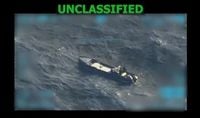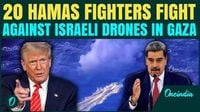For many in Venezuela, the question is no longer whether tensions with Washington will reach a boiling point—they already have. Over the past several weeks, a dramatic surge in U.S. military presence across the Caribbean has fueled anxieties of a looming confrontation, with both sides trading accusations and flexing their military might in a standoff that’s left the region on edge.
The latest escalation began in late September 2025, when Venezuelan president Nicolás Maduro signed a decree granting himself additional powers, a move soon followed by threats of a state of emergency and sweeping military mobilizations. According to The Conversation, Maduro declared Venezuela a “republic in arms,” vowing to defend national sovereignty at all costs and warning that any attack would trigger the full mobilization of his country’s armed forces. If enacted, the state of emergency would last 90 days, centralizing military control under the president’s office and signaling a readiness for direct confrontation.
Meanwhile, Washington has shown no sign of backing down. In September, the U.S. Southern Command deployed a formidable array of warships, aircraft, and Marines to the Caribbean, including the USS Stockdale—now the ninth U.S. Navy vessel and third destroyer to join the USS Iwo Jima Amphibious Ready Group. At least 4,500 Marines and sailors are positioned in the area, with advanced F-35 fighters and MQ-9 drones operating from Aguadilla and Ceiba airports in Puerto Rico. According to Newsweek, satellite imagery captured by MizarVision, a China-based aerospace intelligence firm, revealed at least 10 F-35B stealth jets parked in plain view at Puerto Rico’s José Aponte de la Torre Airport, an unmistakable show of force directed at Caracas.
The Pentagon has also released images of Marine Corps F-35B jets arriving in Ceiba and disclosed new runway construction at the former Roosevelt Roads naval station, all “in support of the U.S. Southern Command mission, Department of War-directed operations, and the president’s priorities.” Nighttime cargo deliveries by Air Force C-17 Globemaster III transport planes and the arrival of additional destroyers and amphibious ships at Puerto Rico’s port of Ponce further underscore the scale of the buildup. The unknown whereabouts of the USS Newport News, a nuclear-powered fast-attack submarine, only add to the sense of uncertainty.
Venezuela has not taken these developments lightly. On September 15, Defense Minister Vladimir Padrino López announced three days of military drills involving naval units, air-defense assets, and militia participation. By early October, Caracas accused U.S. combat aircraft of operating just 46 miles off its northern coast, within the Maiquetía flight information region. In a joint statement, Venezuela’s defense and foreign ministries described the sortie as an “illegal incursion” and a direct threat to national security. General Padrino was unequivocal: “We’re watching them, I want you to know. And I want you to know that this doesn’t intimidate us. It doesn’t intimidate the people of Venezuela. The presence of these planes flying close to our Caribbean Sea is a vulgarity, a provocation, a threat to the security of the nation. I denounce before the world the military harassment, the military threat by the US government against the people of Venezuela, who want peace, work and happiness.”
President Maduro, for his part, has called for a nationwide mobilization, framing the standoff as a defense of sovereignty against imperial aggression. The rhetoric has grown sharper, with Caracas warning that any attack would be met with a “republic in arms.” Yet, as The Conversation notes, Venezuela’s military—though not negligible—has seen its readiness eroded by years of economic crisis, international sanctions, and maintenance shortfalls. While it cannot match U.S. military dominance at sea or in the air, it could nevertheless inflict damage through asymmetric tactics and militia mobilization.
On the U.S. side, the official line remains one of readiness, not war. The current campaign is framed as enhanced counternarcotics operations, with joint patrols and interdiction efforts alongside allies such as the Royal Netherlands Navy, Canada, the Dominican Republic, and the United Kingdom. Still, the presence of stealth fighters, amphibious assault ships, and special operations vessels like the MV Ocean Trader—a converted cargo ship capable of supporting Navy SEAL missions—suggests preparations for rapid escalation if ordered. In a memo to Congress, President Donald Trump stated, “Based upon the cumulative effects of these hostile acts against the citizens and interests of the United States and friendly foreign nations, the president determined that the United States is in a noninternational armed conflict with these designated terrorist organizations.”
Lawmakers in the U.S. are seeking clarity on the legal basis for recent drone strikes against suspected cartel boats, reflecting domestic concerns over the scope of military action and how far Washington is prepared to go. The Trump administration, according to Newsweek, has justified these actions by designating the cartels as terrorist organizations—a move that could portend further strikes.
Internationally, the standoff has drawn in a range of actors, each with their own interests. China, a key buyer of Venezuelan oil, has expressed opposition to the use of force and external interference in Venezuela’s affairs. In late September, Beijing’s ambassador conveyed solidarity to Maduro, emphasizing that China would “firmly support Venezuela in safeguarding sovereignty, national dignity and social stability.” Russia, too, maintains a presence, with its navy making a publicized visit to La Guaira in July 2024 and having sent nuclear-capable bombers to Venezuela in the past. While neither Beijing nor Moscow is likely to intervene militarily, their diplomatic and technical support offers Maduro a modest hedge against external pressure.
Regionally, most governments have steered clear of taking sides, wary of being drawn into a conflict. The president of Dominica, speaking at the United Nations General Assembly, declared, “there is no place in the Caribbean for war.” Guyana, engaged in a territorial dispute with Venezuela over the oil-rich Essequibo region, stands as a notable exception, welcoming U.S. security cooperation. Cuba, long an ally of Caracas, continues to provide intelligence and security advisers, complicating U.S. efforts to destabilize Maduro’s inner circle.
As for the odds of open conflict, several forecasters now estimate roughly a one-in-three chance of some form of U.S. strike against Venezuela before the end of 2025, with the likelihood rising into 2026. Yet the prospect of an outright invasion remains remote, hampered by domestic opposition in the U.S. and the risk of sparking a global oil shock. Instead, the U.S. appears poised to maintain pressure through targeted strikes, sanctions, and shows of force—hoping to weaken the Maduro regime without being drawn into a messy war.
With both sides on high alert and rhetoric hardening, the risk of miscalculation or sudden confrontation has sharply increased. The coming months may well determine whether the current standoff remains a contest of wills or erupts into something far more dangerous.

